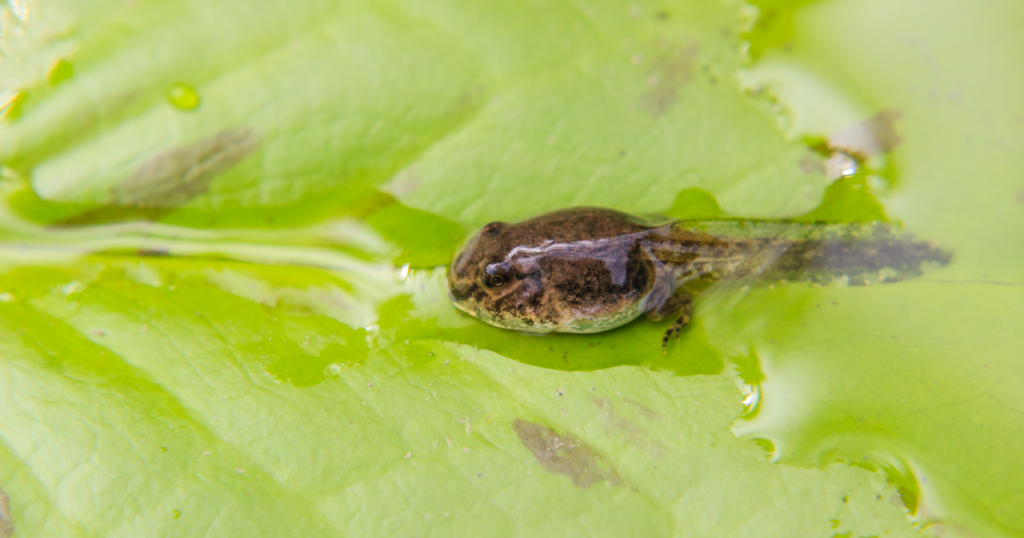
Amphibians are the most threatened vertebrate class worldwide. Because they lack the ability to regulate their own temperature and moisture levels, climate change is playing a significant role in this growing peril (1). Climate change impacts amphibian survival in several ways. In addition to habitat loss, growing drought conditions make maintaining body moisture levels challenging and warming temperatures restrict activity periods needed for reproduction as well as increasing the risk of heat stress.
Heat tolerance varies by species, and understanding what influences these differences could help predict species survival. The gut microbiota is known to affect a wide range of functions in host animals, and recently studies have begun to investigate its role in host thermal tolerance (2).
A Tale of Two Frog Species
Frogs survive over a diverse range of climates. The green frog (Lothobates clamitans) and the wood frog (L. sylvaticus) are closely related and live in similar environments; however, their life cycles are different. Wood frogs develop quickly from egg to adult in cooler spring waters, whereas green frogs spend longer as tadpoles in warmer, summer water. Not surprisingly, green frog tadpoles can tolerate higher water temperatures than those of wood frogs. In a study reported in September (2023) on bioRxiv by researchers from Southern Illinois University and Kanas State University found that manipulating the gut microbiota of wood frog tadpoles to be more like those of the green frogs increased tadpole heat tolerance (3).
When tadpoles hatch, they eat some of their egg jelly as well as the surrounding pond water. The researchers used this behavior to influence the gut microbiota of wood frog tadpoles by washing wood frog eggs with an antibiotic solution and then inoculating the water with the gut bacteria from green frogs. As a result, when the tadpoles hatched and ate their egg jelly, they also ingested some green frog bacteria.
Green Frog Gut Microbiota Help Wood Frog Tadpoles Tolerate Heat
The wood frog tadpoles that ate some of the green frog bacteria could tolerate short periods of time at higher temperatures (38.3°C) compared to tadpoles from eggs left in their natural pond water or those from eggs washed with the antibiotic solution (37.3°C). Although the change of temperature tolerance was small, increased tolerance of even a single degree could play a significant role in survival as environmental waters warm.
An analysis of the microbiota of the tadpoles exposed to the green frog bacteria showed a more diverse population. The researchers identified wide groups of microbes present in microbiota of the more heat tolerant tadpoles, but the mystery that still remains to be solved is how these changes to the microbiota change the heat tolerance of their host.
Working on gut microbiome projects? We have many resources and solutions to help. From a webinar on automating sample preparation for fecal microbiome studies, to medium- and high-througput kits for DNA isolation from fecal samples.
References
- Luedtke, J.A., et al. (2023) Ongoing declines for the world’s amphibians in the face of emerging threats. Nature 622, 308–314.
- Fontaine, S. and Kohl, K. (2023) The microbiome buffers tadpole hosts from heat stress: a hologenomic approach to understanding host-microbe interactions under warming. J. Exp. Biology 226, jeb2451913.
- Dallas, J. et al. (2023)Heat tolerance is Affected by the Gut Microbiota in a Vertebrate Ectotherm bioRxiv preprint (doi: https://doi.org/10.1101/2023.09.07.55668.
Related Posts
Kelly Grooms
Latest posts by Kelly Grooms (see all)
- The Battle of Shiloh’s Angel’s Glow: Fact, Civil War Legend or Modern Myth? - July 11, 2024
- Mind Control, Mutilation and Death. The Fungal Fate That Lurks in Waiting for Emerging Periodical Cicadas - June 13, 2024
- Measles and Immunosuppression—When Getting Well Means You Can Still Get Sick - May 13, 2024
